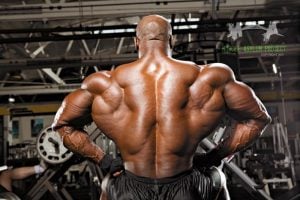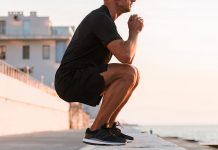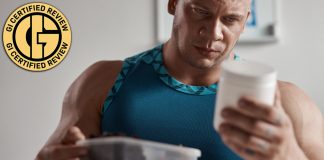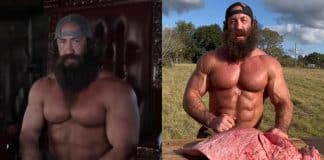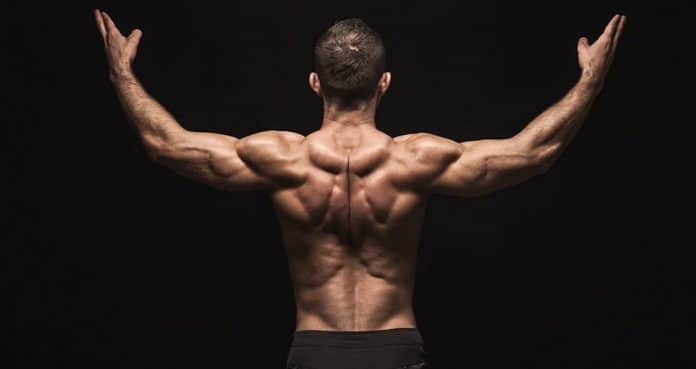
The reverse grip dumbbell row zones in on your lats and biceps.
Bodybuilders and gym-goers, listen up: If you want to sculpt the perfect physique, having a strong back is essential! A strong back gives you the stabilization needed to carry out important bodybuilding exercises like barbell bent-over rows and deadlifts. But slight variations in your grip will hit some back muscles more than others. For example, the reverse grip dumbbell row is a compound exercise that helps to train your back, arms, and lower body, emphasizing your lats and biceps.
It helps to build thickness by targeting the critical muscles like the lats, traps, rhomboids, and rotator cuff (1). It also involves the muscles in your core since it’s activated to brace the movement.
Reverse grip dumbbell rows also work on your deltoids, biceps, and forearms. They challenge and improve your grip strength and enable you to use heavier weights because of the grip. You use your lower body for this exercise, so the hamstrings, gluteus maximus, and quadriceps benefit from the movement too.
Have we convinced you to include the reverse grip dumbbell row in your routines yet? We hope so because the advantages are too numerous to count. Below is an extensive guide on how to do reverse grip dumbbell rows, why you’ll benefit from adding them to your routine, and some alternatives you can try.
How to do Reverse Grip Dumbbell Rows
Reverse grip dumbbell rows are advantageous for building a muscular back, but proper form for this exercise is essential. It’ll help you get all the benefits of this routine safely, no matter how much weight you pack. They’re similar to the barbell reverse grip row, but use a dumbbell instead – which will help you isolate each side better. Here are the steps to follow to do a reverse grip dumbbell row.
- Grab dumbbells with a reverse grip/supinated grip (palms facing up) and spread your feet to shoulder-width apart while keeping your back straight.
- Brace your ab and bend your knees slightly while bringing your torso forward (by hinging your hips). Remember to keep your shoulders down and back. Do this until your body is almost parallel to the ground (about 45 degrees bent).
- At this point, your arms should be hanging straight down. Keep your chin tucked in, and then look at the ground immediately before your feet; this is your starting position.
- While keeping your torso stationary and your wrists straight, bend your arms and pull the dumbbells up to your chest. Lead with your elbows and ensure that your lower back does not become rounded.
- Squeeze your back muscles at the top and hold for a second, then slowly return the weight to your starting position by lowering it. Keep your core tight and your back neutral.
- Repeat for the desired number of reps.
*Tip: Keep your elbows close to your body to ensure that your back is fully engaged. Using your lower back or legs to help lift will take the work away from your target muscles.
Benefits
Reverse grip dumbbell rows work multiple body muscles and help with hypertrophy. The significant difference between the reverse grip and the dumbbell bent-over row is that it emphasizes your lats more. Below are some of the advantages of this exercise.
Bigger Biceps and Lats
The palm-up grip you use for reverse grip rows works like the barbell curl. They put your biceps in a supinated position for bigger biceps. This grip also activates your lats more than the pronated grip.
Aesthetic Physique
As a result of the compound nature of this routine, you’ll use both your upper and lower body muscles. This helps you build a well-rounded look and enhance your general physique.
More Stability
Doing reverse grip dumbbell rows will require stability from your shoulder and core. Properly positioning your spine during the routine will also help stabilize other functional movements.
Greater Strength
A reverse grip doesn’t fatigue as quickly as a pronated grip. So you’ll be able to use a heavier load, leading to more muscle growth.
Better Posture and Correct Muscular Imabalnces
Doing this exercise teaches you how to brace your abs properly and maintain the correct spine position. Proper spine curvature will carry over to other movements. And since this movement is a unilateral exercise, it’ll help fix any muscular imbalances.
Reverse Grip Dumbbell Row Variations
Reverse grip dumbbell rows are an effective exercise for your back, but adding variations to your routine is vital to prevent a plateau. Some people find this exercise places too much stress on their lower back. Here are some alternatives that you can use to switch up your workout and place less strain on your lumbar spine.
Chest Supported Reverse Grip Row
The chest-supported reverse grip row targets your lats, traps, rhomboids, biceps, and delts. This exercise is, however, better for beginners and those with lower back pain. It uses an adjustable bench that you lie on, completely removing the need for the lower back.
Yates Row
Mr. Olympia Dorian Yates made the Yates row famous and used a barbell. In this exercise, you lean over about 45 degrees, which is more lower-back friendly, and you can train with heavier weights.
Reverse Grip Cable Row
The reverse grip cable row offers a more even load distribution than free weights. As a result, some bodybuilders prefer this variation which also targets the same muscles. It’s also lower back friendly.
Reverse Grip Inverted Row
Want to use something other than weights for your routine? The reverse grip inverted row mirrors the effect of the reverse grip dumbbell row with just your body weight (2); it’s performed on a Smith machine or squat rack.
Back Anatomy
Your back comprises three muscle groups: the superficial, intermediate, and deep. For this exercise, we’ll look at the superficial muscles attached to the shoulder bones and affect the movements of your upper limbs. These are the muscles that the reverse grip dumbbell row focuses on.
Trapezius
Also known as the traps, this flat, broad, and triangular muscle is located directly under the skin and originates from the skull.
Latissimus Dorsi
The latissimus dorsi, aka lats, covers a wide area of your lower back. It’s primarily responsible for your upper limb movement.
Rhomboids
The rhomboids are divided into two — the major and the minor rhomboid. They originate from the spinous process and help attach your upper limbs to your ribcage (2).
FAQs
What do reverse grip dumbbell rows work?
Reverse grip dumbbell rows are a compound exercise that works multiple upper and lower body muscles. Some of them include your lats, traps, delts, and biceps.
Are reverse grip dumbbell rows good?
Reverse grip dumbbell rows offer multiple bodybuilding benefits. They’re also an excellent exercise for building your back and working on your forearms.
What is the difference between reverse and normal grip rows?
The reverse grip row happens with your palms up and is typically more comfortable for athletes. However, using it with your elbows closer to your body will allow you to lift heavier and target your lats, traps, and biceps more.
Wrap Up
Reverse grip dumbbell rows are a very effective movement for your back muscles, arms, and lower body. The unique grip helps you lift more, enhancing your lats and biceps gains. However, it can strain your lower back, so variations like chest-supported or inverted rows can help alleviate pressure when needed.
Follow us on Instagram, Facebook, and Twitter for more exercise guides!
References
- Urbanczyk, C. A., Prinold, J. A. I., Reilly, P., & Bull, A. M. J. (2020). Avoiding high-risk rotator cuff loading: Muscle force during three pull-up techniques. Scandinavian journal of medicine & science in sports, 30(11), 2205–2214. https://doi.org/10.1111/sms.13780
- Farrell, C., & Kiel, J. (2022). Anatomy, Back, Rhomboid Muscles. In StatPearls. StatPearls Publishing.


